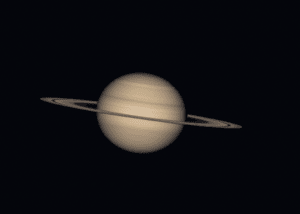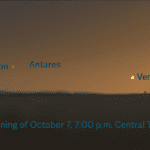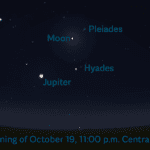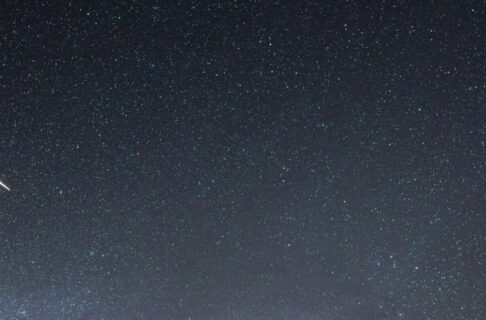October is a great month for stargazing. Aside from the cooler temperatures and earlier sunsets, we have at least one reasonably-bright comet expected, and quite possibly two. The planets rise early enough to see before midnight, and the most distant object visible to the unaided eye comes into view.
Comet #1: 2023 A3 (Tsuchinshen-ATLAS)
This is the comet you’ve been hearing about on social media lately. It’s been limited to southern viewers so far, but now that it has rounded the Sun it will be moving into the northern skies quickly.
There is a full article on this comet, with day-by-day details, in preparation, but the short version is most Canadians won’t be able to spot it until after October 10 or so. It is not quite as bright as forecast, and so it won’t become visible in broad daylight or even in the very bright twilight sky. It will become visible in the evening sky after sun is it rockets between Sun and Erath, rapidly moving higher in the evening as it moves farther away.
Comet #2: A11bP7I (Soon-to-be Comet ATLAS)
This comet was discovered on September 27, and is so new that it doesn’t have a formal name yet – “A11bP7I” is a temporary designation. This comet is a rare kind of comet called a sun-grazer, which gets very close to the Sun and therefore can get very bright. Initial forecasts sound like this one could be even brighter than Comet Tsuchinshen-ATLAS, but we’ll have to wait and see. It will be at its best (whatever taht menas) around the end of october. More informations as it becomes available.
The Solar System
Mercury remains too low to see in the evening sky this month.
Venus is very low in the southwest in the evening sky this month, and remains very low throughout October. It is quite far from the sun, but the angle of the solar system is very close to the angle of Manitoba’s horizon in the fall, keeping the planet low. it is very bright, though, likely the first star you see in the evening if your southwestern horizon is clear.
Mars rises in the northeast before midnight, in the middle of the constellation Gemini the Twins. Mars is slowly approaching our planet and will be at its best this orbit in January 2025.

Jupiter Rises in the northeast about 10pm at the beginning of October, betweemn the horns of taurus the Bull. The largest planet stands high in the south at dawn, offering clear telescopic views. Its four largest moons are visible in binoculars as tiny “stars” in a line on either side of the planet; their positions change nightly as they orbit the giant planet.
Saturn is low in the southwest at sunset, and is visible all night. It rises only about 30 degrees up in the south at its best, though, so telescope views are still blurred by the Earth’s atmosphere. The rings are nearly edge-on, but visible in a telescope with more than about 30x magnification./
Sky Calendar for October 2024
Click on highlighted dates for a star chart showing the view!
Oct. 2 : New Moon
Oct. 5 (evening): The thin crescent Moon will be below Venus in the evening sky after sunset (likely invisible except with binoculars and very clear skies).
Oct. 6 (evening): The thin crescent Moon will be to the left of Venus in the evening sky after sunset.
Oct. 7 (evening): The thin crescent Moon will be just to the to the left of the bright star Antares in the evening sky after sunset. Venus stands farther to the right. 
Oct. 9 (evening): Comet Tsuchinshen-ATLAS passes between Earth and Sun, passing just above the Sun from our point of view. The comet will likely be at its brightest today, but not visible because of its closeness to the Sun.
Oct. 10 (evening): First Quarter Moon. Also the beginning of likely period of visibility for Comet Tsuchinshen-ATLAS. See day-by-day coverage posts .
Oct. 13 (evening): Saturn will be the brightest “star”, far to the left of the waxing gibbous Moon tonight.
Oct. 14 (evening): Saturn will be the brightest “star” to the right of the waxing gibbous Moon tonight.
Also tonight, Comet Tsuchinshen-ATLAS passes another, much fainter, comet: Comet 13P/Olbers. Olbers is a periodic comet that has been visible in mid-sized telescopes for a while, and the two aren’t physically close4 to each other, but just in our line of sight from Earth.
Oct. 15 (evening): Comet Tsuchinshen-ATLAS passes near the globular cluster M5, a “faint fuzzy” visible in binoculars. Images of the comet on this night will probably also catch the globular cluster, which is a group of several hundred thousand stars which are among the oldest stars visible.
Oct. 17: Full Moon, the Harvest Moon.
Oct. 19 (all night): The waning gibbous Moon sits between the Pleiades and Hyades star clusters tonight, with bright Jupiter nearby to the lower left.
Oct. 20 (all night): The waning gibbous Moon is above Jupiter tonight as the two rise in the northeast about 9 p.m. local time.
Oct. 23 (morning): The nearly last quarter Moon is near a trio of bright stars. From top to bottom they are Castor and Pollux, in the constellation Gemini, and the red planet Mars.
Oct. 24 (morning): A similar view to yesterday morning’s sky, but with the Moon having moved through the trio to sit on the lower left of the scene.
Oct. 24 : Last Quarter Moon.
Oct. 28: The new comet A11bP7I makes its closest approach to the Sun. More updates as they become available.
Oct. 31 (evening): Hallowe’en, a great night to have your telescopes or binoculars out to show trick-or-treaters the sky.





